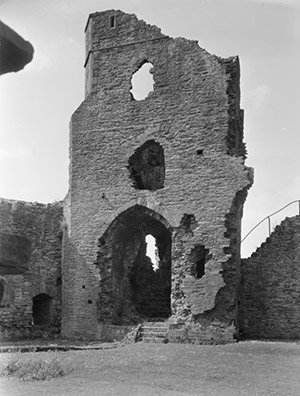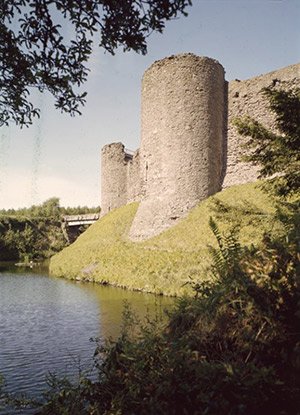
Grosmont Castle taken in 1952
Grosmont, Skenfrith and Llantilio Crossenny were more than fortresses guarding the Monnow Valley. Helen Morgan from Abergavenny Local History Society reports
After the Normans arrived, these earth-and-timber strongholds were built to protect links between Hereford and Wales. They became seats of power and symbols of domination in an area whose population was almost entirely Welsh. Accounts from 1256-57 show that the lord of the three castles enjoyed revenue from the market and mill, from pigs foraging in the woods, eels caught on a weir in the Monnow and from Jews who paid him £13s 4d for the privilege of living in Grosmont.
For most of their history, the three castles have been in the hands of a single owner. They were rebuilt in stone by Hubert de Burgh in the 13th century in the face of a Welsh uprising under Llywelyn ap Gruffudd. Grosmont (Y Grysmwnt) was built on a hill, Skenfrith (Ynysgynwraidd) in a valley and Llantilio (renamed White Castle) was built on a plain. In Grosmont and Skenfrith, a church and village grew up around the castle, although the name Ynysgyrwraidd is thought to have derived from a Welsh chieftain (Cynfraeth) who lived there with his court (Ynys) in the 6th century. White Castle, however, is over a mile from the village of Llantilio Crossenny whose church was part of the Llandaff ecclesiastical estate, also in the 6th century. Its role also appears to have been primarily that of a military garrison as it lacked the domestic accommodation suitable for the nobility found at Grosmont and Skenfrith.

White Castle taken in 1974
A distinctive feature of the round keeps of the Southern March castle is a semi-circular projection, carrying a stair or latrine. At Skenfrith a turret carries a circular newel staircase from the first floor to the second and upwards to the roof. The upper chamber had two windows, large hooded fireplace and latrine. This might have been a sitting and bedroom for Hubert de Burgh’s family.
At Grosmont, the bridge across the castle ditch is on the line of its medieval predecessor and leads through a gatehouse to the inner ward. A spiral staircase in the hall leads to the upper storey where a fireplace can be seen with part of its chimney still intact. By the 16th century the three castles were abandoned but are now in the safe hands of CADW.
Jane White will lead a tour of the Three Castles on June 19, departing at 1pm. For further details contact Diane Bevan on 01873 857334 or via dianebevan4@gmail.com
